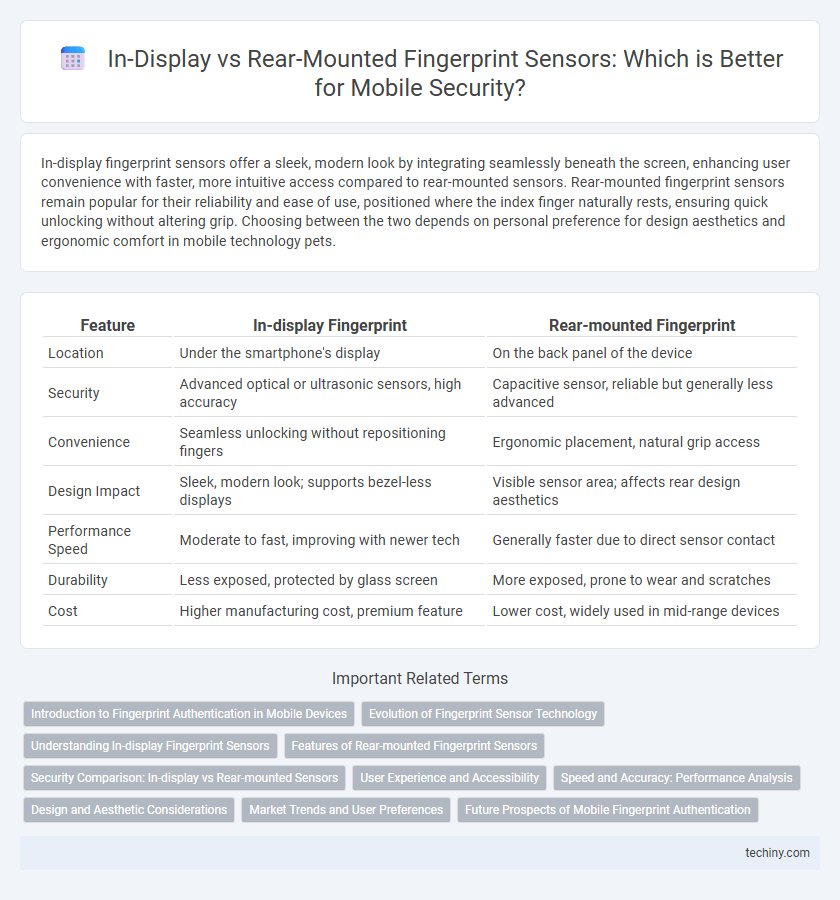In-display fingerprint sensors offer a sleek, modern look by integrating seamlessly beneath the screen, enhancing user convenience with faster, more intuitive access compared to rear-mounted sensors. Rear-mounted fingerprint sensors remain popular for their reliability and ease of use, positioned where the index finger naturally rests, ensuring quick unlocking without altering grip. Choosing between the two depends on personal preference for design aesthetics and ergonomic comfort in mobile technology pets.
Table of Comparison
| Feature | In-display Fingerprint | Rear-mounted Fingerprint |
|---|---|---|
| Location | Under the smartphone's display | On the back panel of the device |
| Security | Advanced optical or ultrasonic sensors, high accuracy | Capacitive sensor, reliable but generally less advanced |
| Convenience | Seamless unlocking without repositioning fingers | Ergonomic placement, natural grip access |
| Design Impact | Sleek, modern look; supports bezel-less displays | Visible sensor area; affects rear design aesthetics |
| Performance Speed | Moderate to fast, improving with newer tech | Generally faster due to direct sensor contact |
| Durability | Less exposed, protected by glass screen | More exposed, prone to wear and scratches |
| Cost | Higher manufacturing cost, premium feature | Lower cost, widely used in mid-range devices |
Introduction to Fingerprint Authentication in Mobile Devices
Fingerprint authentication in mobile devices enhances security by using biometric data for user verification. In-display fingerprint sensors utilize optical or ultrasonic technology embedded beneath the screen, offering seamless integration with modern smartphones. Rear-mounted fingerprint scanners remain popular for their reliability and ease of access, especially on devices with larger displays.
Evolution of Fingerprint Sensor Technology
In-display fingerprint sensors represent a significant evolution from traditional rear-mounted sensors by integrating biometric authentication directly into the smartphone screen, enhancing both aesthetics and user convenience. Advances in optical and ultrasonic sensor technologies have enabled these in-display sensors to offer faster, more accurate, and secure fingerprint recognition compared to early rear-mounted modules. This shift reflects ongoing innovation aimed at maximizing screen real estate while improving seamless, contactless device unlocking experiences.
Understanding In-display Fingerprint Sensors
In-display fingerprint sensors utilize optical or ultrasonic technology to capture fingerprint data directly through the smartphone screen, offering a seamless and modern authentication method. These sensors enable thinner device designs by eliminating the need for dedicated fingerprint modules on the rear, enhancing aesthetic appeal and user convenience. Despite generally slower response times compared to rear-mounted sensors, ongoing advancements in sensor resolution and processing algorithms are rapidly improving accuracy and speed.
Features of Rear-mounted Fingerprint Sensors
Rear-mounted fingerprint sensors offer quick and ergonomic access, positioned where the index finger naturally rests, enhancing user convenience and reducing accidental touches. These sensors provide reliable biometric authentication with minimal screen space usage, enabling larger display sizes without compromising security features. They are generally cost-effective and compatible with a wider range of phone designs, supporting robust fingerprint recognition even with wet or dirty fingers.
Security Comparison: In-display vs Rear-mounted Sensors
In-display fingerprint sensors utilize optical or ultrasonic technology to capture fingerprint data directly through the smartphone screen, offering advanced encryption and reduced risk of spoofing compared to traditional rear-mounted sensors. Rear-mounted fingerprint sensors, often based on capacitive technology, remain susceptible to physical wear and potential unauthorized access due to their exposed placement. Overall, in-display sensors provide enhanced biometric security integrated with modern mobile architectures, minimizing vulnerabilities inherent in rear-mounted fingerprint recognition systems.
User Experience and Accessibility
In-display fingerprint sensors offer seamless unlocking by integrating directly into the screen, enhancing user experience with faster, more intuitive access while maintaining sleek device aesthetics. Rear-mounted fingerprint sensors provide ergonomic placement for thumb reach during one-handed use, benefiting users who prioritize natural grip and muscle memory in accessibility. Both technologies improve security and convenience, but in-display sensors support edge-to-edge display designs, whereas rear-mounted sensors may be more accessible for users with limited hand mobility.
Speed and Accuracy: Performance Analysis
In-display fingerprint sensors offer moderate speed and accuracy, relying on optical or ultrasonic technology that can sometimes struggle with wet or dirty fingers. Rear-mounted fingerprint sensors typically provide faster and more consistent recognition due to direct capacitive scanning, ensuring higher accuracy in diverse conditions. Devices with rear-mounted sensors often outperform in speed tests, while in-display sensors excel in design integration but may sacrifice slight responsiveness.
Design and Aesthetic Considerations
In-display fingerprint sensors enable a sleek, uninterrupted front design, enhancing the modern aesthetic of smartphones by eliminating the need for physical buttons or visible sensor pads. Rear-mounted fingerprint sensors, while more traditional, often disrupt the back panel's smoothness and may limit design flexibility due to sensor placement constraints. The choice between these technologies significantly impacts the device's overall visual appeal and user experience, with in-display sensors offering a more futuristic and minimalist look.
Market Trends and User Preferences
In-display fingerprint sensors are gaining significant market traction due to their integration with bezel-less smartphone designs, appealing to users prioritizing aesthetics and seamless screen experience. Rear-mounted fingerprint scanners remain popular in mid-range devices, offering faster and more reliable authentication favored by users seeking practicality and cost-effectiveness. Market trends indicate a growing shift towards in-display technology driven by OLED panel adoption and consumer demand for innovative biometric solutions.
Future Prospects of Mobile Fingerprint Authentication
In-display fingerprint technology offers seamless integration with evolving mobile designs, enhancing user convenience and security through advanced optical and ultrasonic sensors. Rear-mounted fingerprint scanners, while reliable and cost-effective, face limitations in user ergonomics and device aesthetics as smartphones trend toward bezel-less displays. Future prospects indicate a shift toward under-display biometrics combined with AI-driven authentication methods, aiming to provide faster, more secure, and unobtrusive fingerprint recognition in mobile devices.
In-display Fingerprint vs Rear-mounted Fingerprint Infographic

 techiny.com
techiny.com